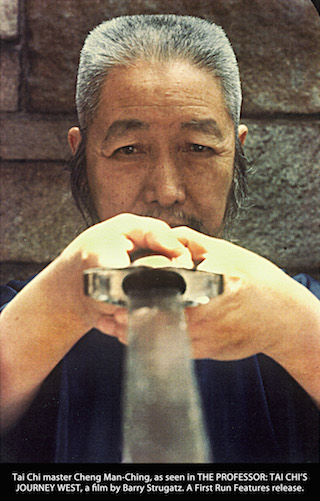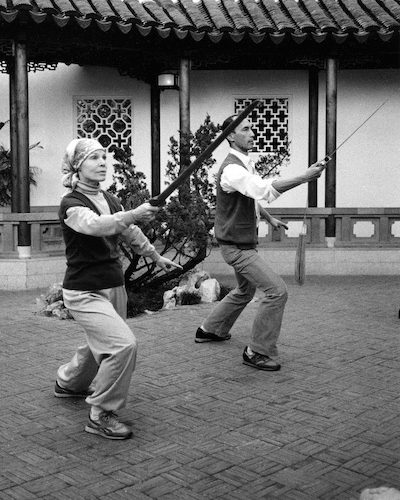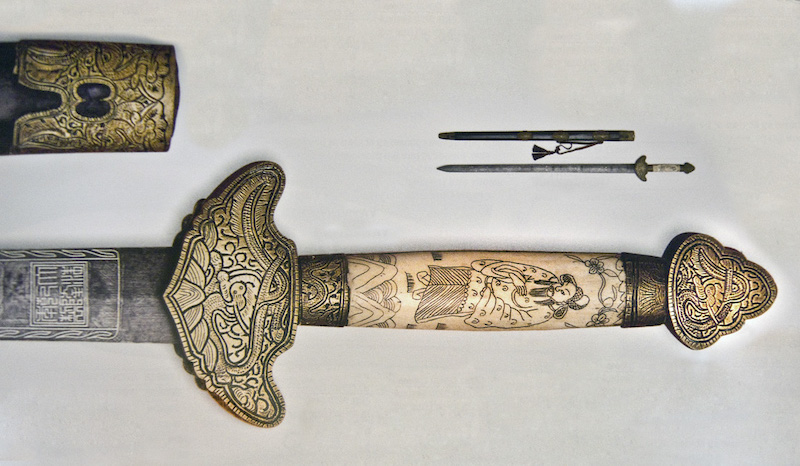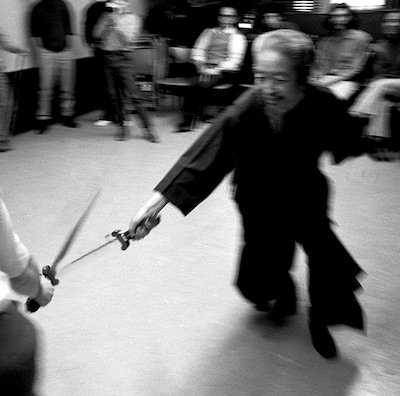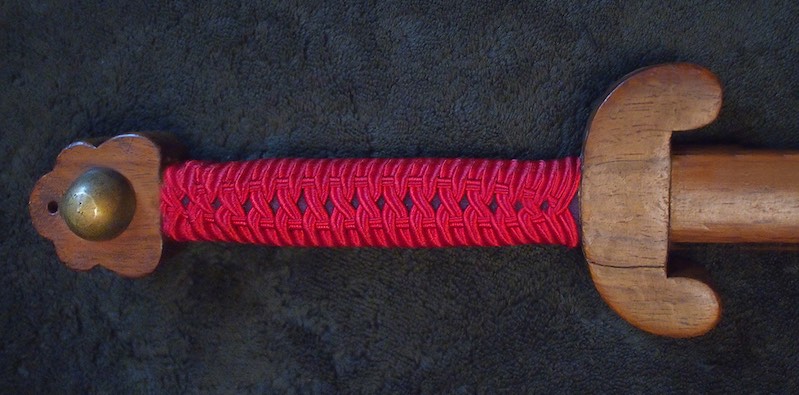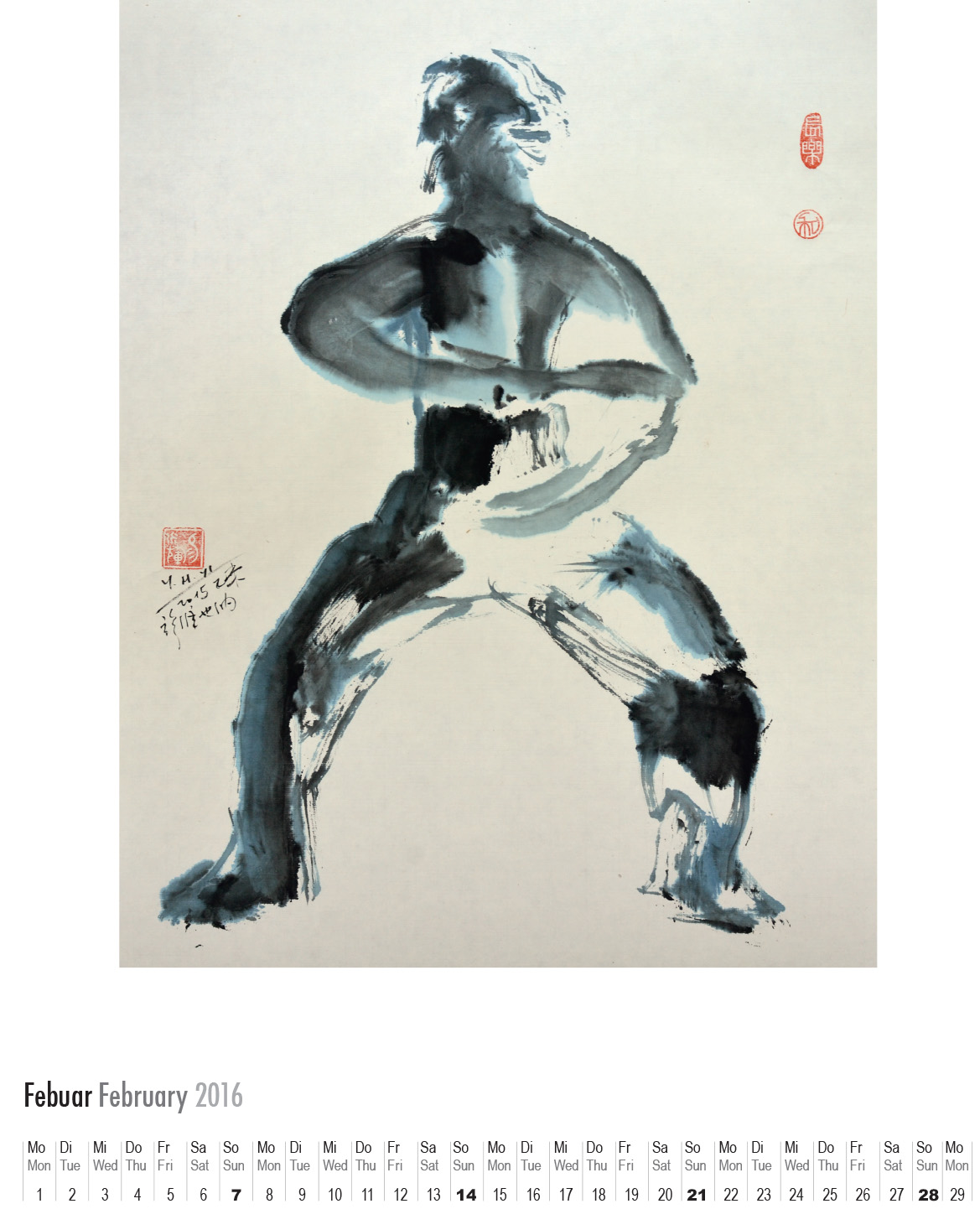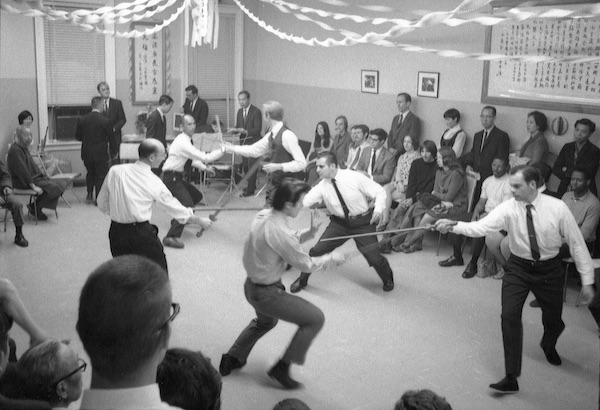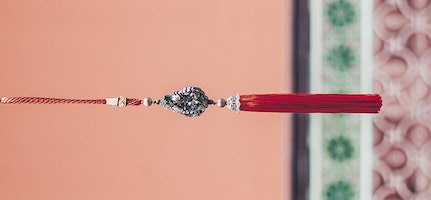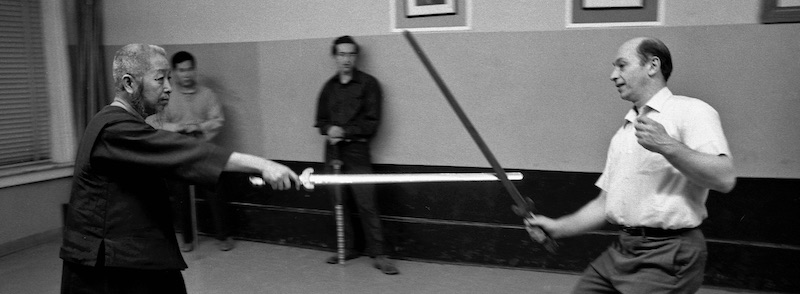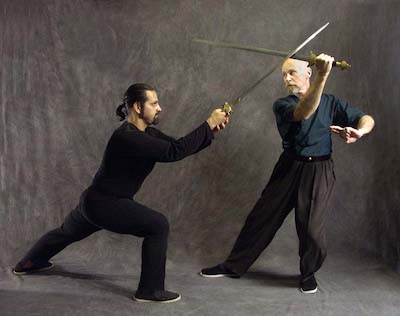RULES OF ENGAGEMENT
Your goals will dictate how you manage the process. You may want to exercise, duel, win, dominate others, stimulate your joints and improve your health, develop an intimate relationship with an instrument, evolve by following a ‘way’ or exercise the spirit.
After having studied Tai Chi form, push hands and sword form for several years, practised the core exercises and learned how to grip and move the sword we may begin to fence.
The first thing we do is to contact the O’s blade with our blade and try to maintain that contact, as this is our defence and our path of communication with the O.
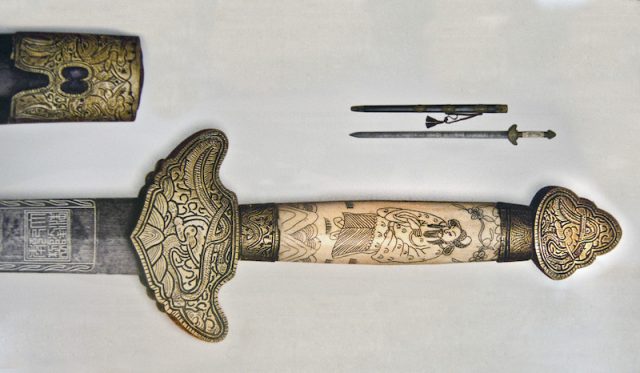
The second rule of engagement is to keep our blade between the O’s blade and our body. If the O’s blade can see a part of our body without our blade in between, it can cut us easily. If our blade can see a part of his body without his blade being in between, then we can cut him.
Now as we are standing there with our blades in contact, neither of us have any advantage or disadvantage, in order to provoke action, one of us can begin to move our blade away from the O’s blade to see if the O sticks with us. This must be done as we maintain contact, without any gaps and without any pressure on the other blade. As we continue circling blades, we need to notice when the O shows any excess or deficiency, which we then take as an invitation to cut them, that is, if they do too much or too little, in terms of energy, attention, alignment or execution.
We want to keep the O more or less in front of us. If they choose to circle to our left we may circle to our right, if they circle to our right we may circle to our left. If the O advances directly at us, we must get out of the way, mostly by circling to our left, this brings us close to the right side of the O, and we gain an advantage as our left hand closes with their right hand (sword hand), giving us the option to contact and control it.
For the most part we keep our point toward or threatening the O. Any time we bring our point out of alignment with the O, we become more vulnerable.
When the O presses his blade on ours, we must use that energy to cut him. Usually our blade will describe a circle, as we cut to his limb or body.
The way I have described above, being the most important phase of our fencing, is at once teaching us to apply the Tai Chi principles to fencing, as well as fine-tuning these principles as they apply to our everyday life.
Many students do not stay long at this first level. They constantly revert to using strength and speed in an attempt to win. Some simply stay at this level because it is such a demanding and satisfying experience.
SUMMARY
- Keep in contact, stick to the O’s blade.
- Keep our blade between the O’s blade and our body.
- Get out of the way, circle.
- Keep our point threatening the O.
- Use the O’s energy as an invitation to cut him.
WE DO NOT
- ‘Beat’ the O’s blade to get it out of the way.
- Try to control the O or his blade.
- Put pressure on the O’s blade in attack or in defence.
- ‘Disengage’ without due cause.
- Use our sword as a barrier or oppose the O’s Sword.
- Back up more than one step.
Author and Images: Ken van Sickle
German version on our sister site!
- ON BEING A MASTER – Tai Chi Sword 53
- STRANGERS – Tai Chi Sword 52
- PADDED SWORDS – Tai Chi Sword 51
- SAFETY – Tai Chi Sword 50
- PARALLELS – Tai Chi Sword 49
- Swordsmanship – SEVEN QUOTES – Tai Chi Sword 48
- TI FENG & FA JING – Tai Chi Sword 47
- SUPPOSITIONS – Tai Chi Sword 46
- LAO TZU (Laozi) QUOTES – Tai Chi Sword 45
- ETIQUETTE – Tai Chi Sword 44
- FENCING PROCESS – Tai Chi Sword 43
- STRATEGIES – Tai Chi Sword 42
- TASSELS IN THE WIND – Tai Chi Sword 41
- SHOOT FLYING GOOSE – Tai Chi Sword 40
- RHINOCEROS GAZES AT MOON – Tai Chi Sword 39
- THE MASTER SITS BACK – Tai Chi Sword 38
- FIVE APPLICATIONS – 1. BLOCK AND SWEEP – Tai Chi Sword 37
- RULES OF ENGAGEMENT – Tai Chi Sword 36
- CONSIDER – Tai Chi Sword 35
- INVITATIONS – Tai Chi Sword 34
- THE TASSEL – Tai Chi Sword 33
- THE SWORD FINGERS – Tai Chi Sword 32
- Cheng Man Ching Photographs
- THE JOINTS – Tai Chi Sword 31
- THE GRIP – Tai Chi Sword 30
- SWORD MOVEMENT – Tai Chi Sword 29
- ON ALIGNMENT – Tai Chi Sword 28
- CONCERNING THE CENTRE – Tai Chi Sword 27
- EQUATIONS – Tai Chi Sword 26
- HSIN AND CHI – Tai Chi Sword 25
- On studying – NINE QUOTES – Tai Chi Sword 24
- THE SWORD MAIDENS – Tai Chi Sword 23
- THE SWORD AND CALLIGRAPHY – Tai Chi Sword 22
- Returning – MORE THOUGHTS – Tai Chi Sword 21
- Levels of TAI CHI SWORD – Tai Chi Sword 20
- FENCING – Tai Chi Sword 19
- Transcendence – Tai Chi Sword 18
- TURNING TRICKS – Tai Chi Sword 17
- Names of CHENG MAN CH’ING’S TAI CHI SWORD – Tai Chi Sword 16
- FORCE – Tai Chi Sword 15
- DIFFERENCES – Tai Chi Sword 14
- BEGINNERS’ MISTAKES – Tai Chi Sword 13
- MIND SETS – Tai Chi Sword 12
- SENSITIVITY – Tai Chi Sword 11
- HARMONY – Tai Chi Sword 10
- TIME AND HUMOUR – Tai Chi Sword 9
- WHY AND HOW – Tai Chi Sword 8
- SWORD DIMENSIONS – Tai Chi Sword 7
- A ROYALTY OF ARMS – Tai Chi Sword 6
- KENNETH VAN SICKLE – Tai Chi Sword 4
- CHENG MAN CH’ING – Tai Chi Sword 5
- PREFACE – Tai Chi Sword 3
- Introductory Thoughts – Tai Chi Sword 2
- EDITOR’S PREFACE -Tai Chi Sword 1
- Tai Chi Sword by Kenneth van Sickle

